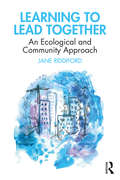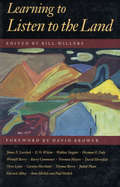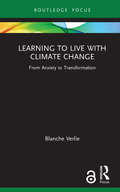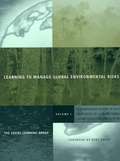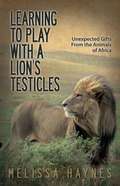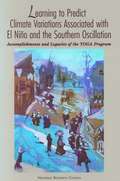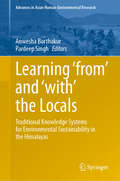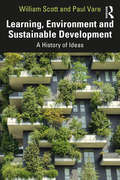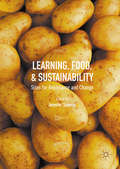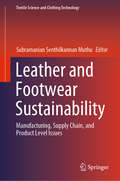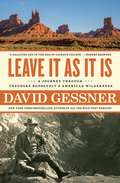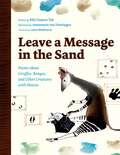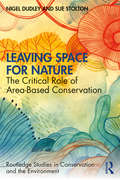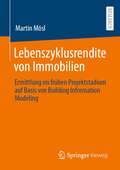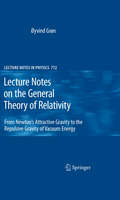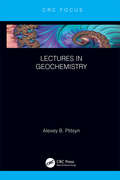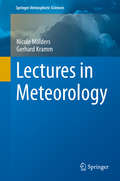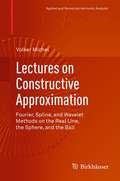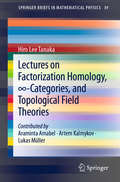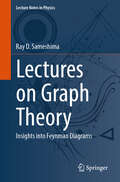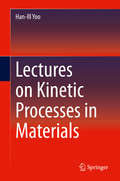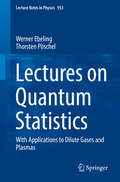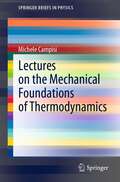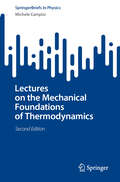- Table View
- List View
Learning to Lead Together: An Ecological and Community Approach
by Jane RiddifordNever before has there been such strong recognition of the importance of community-based green spaces to local communities and urban redevelopment. This book is an autoethnographic account of the challenges and breakthroughs of learning to lead together. The interwoven stories provide first-hand, evocative examples of how an ecological and community approach to organisational development and urban regeneration helped shift the business as usual paradigm. It will help you identify and step beyond individualistic and ‘heroic’ notions of leadership, and will inspire you to find your own way of embracing natural and shared authority. The book focuses on the experiences of developing an environmental education charity in London; Global Generation. It shows how action research, nature practice and storytelling has successfully grown shared purpose, trust and collaboration, both within Global Generation and in the wider community. The style and structure of the book reflects the participatory approach that it presents. The author, Jane Riddiford, deliberately challenges the norms of authorship, which is shaped by the dominant Western narrative – objective, authorless and ‘othered’. This book goes beyond this narrow framework, combining different styles of writing, including traditional and autobiographical storytelling, diary entries and co-writing. Along with practice accounts of what happened, challenges raised and lessons learned, each chapter will also include other people’s descriptions of their experience of being involved in the process.
Learning to Listen to the Land
by William B. WillersIn this inspired collection, some of America's most provocative thinkers and writers reflect on nature and enviornmetnal science--reaching compelling conclusions about humanity's relationship to the earth. Balanced by science and fact,Learning to Listen to the Landexplains the significance of our modern environmental crisis. The authors underscore the necessity forworking within, rather than counter to, our larger ecosystem. Learning to Listen to the Land represents the sounding of an alarm. It's authors call on us to recognize the consequences of our actions, and inactions, and to develop a sense of connection with the earth.
Learning to Live with Climate Change: From Anxiety to Transformation (Routledge Focus on Environment and Sustainability)
by Blanche VerlieThis imaginative and empowering book explores the ways that our emotions entangle us with climate change and offers strategies for engaging with climate anxiety that can contribute to social transformation. Climate educator Blanche Verlie draws on feminist, more-than-human and affect theories to argue that people in high-carbon societies need to learn to ‘live-with’ climate change: to appreciate that human lives are interconnected with the climate, and to cultivate the emotional capacities needed to respond to the climate crisis. Learning to Live with Climate Change explores the cultural, interpersonal and sociological dimensions of ecological distress. The book engages with Australia’s 2019/2020 ‘Black Summer’ of bushfires and smoke, undergraduate students’ experiences of climate change, and contemporary activist movements such as the youth strikes for climate. Verlie outlines how we can collectively attune to, live with, and respond to the unsettling realities of climate collapse while counteracting domineering ideals of ‘climate control.’ This impressive and timely work is both deeply philosophical and immediately practical. Its accessible style and real-world relevance ensure it will be valued by those researching, studying and working in diverse fields such as sustainability education, climate communication, human geography, cultural studies, environmental sociology and eco-psychology, as well as the broader public.
Learning to Manage Global Environmental Risks
by Social Learning GroupThis book examines how ideas, interests, and institutions affect management practice; how management capabilities in other areas affect the ability to deal with environmental issues; and how learning affects society's approach to the global environment.
Learning to Play With a Lion's Testicles
by Melissa HaynesThe cheeky title of Melissa Haynes's story of adventure in Africa, Learning to Play with a Lion's Testicles, earned the book some big publicity on NBC-TV/Late Night with Jimmy Fallon on September 4,2013 where it topped the show's list of "Titles Not to Read" for September 2013. Melissa's book was also a big smash on the March 11, 2014 Ellen Show, where Ellen and guest Ricky Gervais highlighted the book throughout the entire hour. Playing with a lion's testicles: An African saying that means to take foolhardy chances.Melissa, an exhausted executive from the city seeks meaning and purpose from her work, and volunteers for a Big Five conservation project in South Africa. Her boss, an over-zealous ranger, nicknamed the Drill Sergeant, has no patience for city folk, especially if they're women, and tries to send her packing on day one. But Melissa stands her ground with grit and determination, however shaky it may be.Conflict soon sets the pace with a cast filled with predatory cats, violent elephants, and an on-going battle of wits with the Drill Sergeant. Even Mother Nature pounds the reserve with the worst storm in a century. But the most enduring and profound conflict is the internal battle going on within Melissa, as she tries to come to terms with the guilt surrounding her mother's death. When death grips the game reserve, it is the very animals Melissa has come to save that end up saving her.For the reader who has ever dreamed of going to Africa or knows the pain of loss and guilt, LEARNING TO PLAY WITH A LION'S TESTICLES will fill your soul.
Learning to Predict Climate Variations Associated with El Niño and the Southern Oscillation: Accomplishments and Legacies of the TOGA Program
by Advisory Panel for the Tropical Oceans Global Atmosphere ProgramThe TOGA (Tropical Ocean and Global Atmosphere) Program was designed to study short-term climate variations. A 10-year international program, TOGA made El Nino a household word. This book chronicles the cooperative efforts of oceanographers and meteorologists, several U.S. government agencies, many other nations, and international scientific organizations to study El Nino and the Southern Oscillation (ENSO).It describes the progression from being unable to detect the development of large climate variations to being able to make and use rudimentary climate predictions, especially for some tropical countries. It examines the development of the TOGA Program, evaluates its accomplishments, describes U.S. participation in the program, and makes general recommendations for developing better understanding and predictions of climate variations on seasonal to interannual time scales.
Learning ‘from’ and ‘with’ the Locals: Traditional Knowledge Systems for Environmental Sustainability in the Himalayas (Advances in Asian Human-Environmental Research)
by Pardeep Singh Anwesha BorthakurThis book aims to capture the fading traditional knowledge systems of local and indigenous communities in the Himalayas. As many of these practices are at risk of disappearing, the book serves as a valuable record. It encourages readers to reflect on the implications of such knowledge for environmental sustainability today. Focusing on one of the most crucial mountain ranges globally, the book emphasizes the importance of learning ‘from’ and ‘with’ the locals about their lived experiences in the Himalayas. Understanding their unique set of traditional knowledge and technologies is crucial for building climate resilience and effective environmental management. With contributions from experts across the Himalayan region, the book strives for a comprehensive grasp of environmental challenges and potential solutions. Beyond documentation, the goal is to explore opportunities for integrating traditional knowledge with modern scientific approaches. Recognizing the urgency, the book advocates for the preservation of local and indigenous knowledge to address the ongoing global environmental crisis.
Learning, Environment and Sustainable Development: A History of Ideas
by William Scott Paul VareThis book is an introduction to the long history of human learning, the environment and sustainable development – about our struggles with the natural world: first for survival, then for dominance, currently for self-preservation, and in future perhaps, even for long-term, mutually beneficial co-existence. It charts the long arc of human–environment relationships through the specific lens of human learning, putting on record many of the people, ideas and events that have contributed, often unwittingly, to the global movement for sustainable development. Human learning has always had a focus on the environment. It’s something we’ve been engaged in ever since we began interacting with our surroundings and thinking about the impacts, outcomes and consequences of our actions and interactions. This unique story told by the authors is episodic rather than a connected, linear account; it probes, questions and re-examines familiar issues from novel perspectives, and looks ahead. The book is of particular interest to those studying (and teaching) courses with a focus on socio-economic and environmental sustainability, and non-governmental organisations whose work brings them face-to-face with the general public and social enterprises.
Learning, Food, and Sustainability
by Jennifer SumnerThis edited volume explores the intersection of learning and food, both within and beyond the classroom, all within the context of sustainability. Taking a broad pedagogical approach to the question of food, it focuses on learning and change in a number of key sites including schools, homes, communities, and social movements, keeping in mind that we need to learn our way out of our current unsustainable food system and in to more sustainable alternatives.
Leather and Footwear Sustainability: Manufacturing, Supply Chain, and Product Level Issues (Textile Science and Clothing Technology)
by Subramanian Senthilkannan MuthuThis book examines the manufacturing, supply chain and product-level sustainability of leather and footwear products. This book deals with the environmental and chemical sustainability aspects pertaining to the tanning supply chain and the related mitigation measures. The book also explores interesting areas of leather and footwear sustainability, such as waste & the 3R’s and their certification for sustainability. At the product level, the book covers advanced topics like the circular economy and blockchain technology for leather and footwear products and addresses innovation development and eco-material use in footwear by investigating environmental sustainability and the use of bacterial cellulose, a potential sustainable alternative for footwear and leather products.
Leave It As It Is: A Journey Through Theodore Roosevelt's American Wilderness
by David GessnerBestselling author David Gessner&’s wilderness road trip inspired by America&’s greatest conservationist, Theodore Roosevelt, is &“a rallying cry in the age of climate change&” (Robert Redford).&“Leave it as it is,&” Theodore Roosevelt announced while viewing the Grand Canyon for the first time. &“The ages have been at work on it and man can only mar it.&” Roosevelt&’s pronouncement signaled the beginning of an environmental fight that still wages today. To reconnect with the American wilderness and with the president who courageously protected it, acclaimed nature writer and New York Times bestselling author David Gessner embarks on a great American road trip guided by Roosevelt&’s crusading environmental legacy. Gessner travels to the Dakota badlands where Roosevelt awakened as a naturalist; to Yellowstone, Yosemite, and the Grand Canyon where Roosevelt escaped during the grind of his reelection tour; and finally, to Bears Ears, Utah, a monument proposed by Native Tribes that is currently embroiled in a national conservation fight. Along the way, Gessner questions and reimagines Roosevelt&’s vision for today&’s lands. &“Insightful, observant, and wry,&” (BookPage) Leave It As It Is offers an arresting history of Roosevelt&’s pioneering conservationism, a powerful call to arms, and a profound meditation on our environmental future.
Leave a Message in the Sand: Poems about Giraffes, Bongos, and Other Creatures with Hooves
by Bibi Dumon TakWhat would a boar text to a pig, a camel post on a dating site, or a goat shout from the mountaintops? In this unforgettable poetry collection, even-toed ungulates take the spotlight. Ever asked a giraffe about the clouds, read an okapi&’s letter to the editor, or debated which gnu would win the race across the Serengeti? Playful poems and whimsical illustrations feature hoofed creatures from all around the world, from Siberian musk deer to African dik-diks to South American vicuñas. Weaving together humor, scientific detail, and a poignant concern for conservation, Leave a Message in the Sand introduces readers to wild creatures with even wilder things to say.
Leaving Space for Nature: The Critical Role of Area-Based Conservation (Routledge Studies in Conservation and the Environment)
by Nigel Dudley Sue StoltonThis book provides the first contemporary assessment of area-based conservation and its implications for nature and society. Now covering 15 per cent of the land surface and a growing area of ocean, the creation of protected areas is one of the fastest conscious changes in land management in history. But this has come at a cost, including a backlash from human rights organisations about the social impacts of protected areas. At the same time, a range of new types of area-based conservation has emerged, based on indigenous people’s territories, local community lands and a new designation of “other effective area-based conservation measures”. This book provides a concise overview of the status and possible futures of area-based conservation. With many people calling for half the earth’s land surface to remain in a natural condition, this book taps into the urgent debate about the feasibility of such an aim and the ways in which such land might be managed. It provides a timely contribution by people who have been at the centre of the debate for the last twenty years. Building on the authors’ large personal knowledge, the book draws on global case studies where the authors have firsthand experience, including Yosemite National Park (USA), Blue Mountains National Park (Australia), Bwindi National Park (Uganda), Chingaza National Park (Colombia), Ustyart Plateau (Kazakhstan), Snowdonia National Park (Wales) and many more. This book is essential reading for students, academics and practitioners interested in conservation and its impact on society.
Lebenszyklusrendite von Immobilien: Ermittlung im frühen Projektstadium auf Basis von Building Information Modeling
by Martin MöslZur Sicherstellung des Werterhalts von Immobilien werden zunehmend nachhaltige Aspekte im Planungsprozess berücksichtigt. Dies erfordert bereits in der Phase der Projektentwicklung eine ganzheitliche Betrachtung sowohl der zur Errichtung und zum Betrieb eines Gebäudes entstehenden Aufwände bestehend aus Errichtungs- und Folgekosten (=Lebenszykluskosten) als auch der in der Betriebsphase zu erwartenden Erträge. Durch die Gegenüberstellung der Aufwände zu den Erträgen ergibt sich die Lebenszyklusrendite (LZR) als Faktor zur Prognose der Rentabilität einer Investition. Das Ziel dieser Arbeit ist die Entwicklung einer Methodik zur kostenoptimierten und lebenszyklusorientierten Steuerung der Gebäudeplanung entweder in der Phase der Projektentwicklung oder in einer frühen Planungsphase in Kombination mit der Anwendung von "Building Information Modeling" (BIM). Als Grundlage für diese Methodik wird die frühzeitige Einbindung der zu diesem frühen Zeitpunkt vorhandenen Erkenntnisse in ein Bauwerksmodell untersucht, um eine Steigerung der Produktivität und Effizienz in den nachfolgenden Planungsphasen zu erreichen. Die automatisierte Ermittlung der LZR erfolgt durch ein seitens des Autors entwickeltes Software Tool.
Lecture Notes on the General Theory of Relativity
by Øyvind GrønThis book is the result of more than twenty years of lecturing a master course on the General Theory of Relativity at the University of Oslo, Norway, by Dr. Øyvind Grøn. The text has been continuously updated by Dr. Grøn and is written so students can follow the deductions all the way throughout the book. The conceptual content of the general theory of relativity is presented briefly but reasonably and completely. Both bachelor students and master students will find the text useful as the manuscript is organized to easily find the topics one wants to read about, with separate lists of contents, figures, definitions, examples, and an index.
Lectures in Geochemistry
by Alexey B. PtitsynThis book is a brief summary of the course of lectures in Geochemistry for undergraduate and graduate students from other than Geological Departments (chemists, biologists, ecologists and naturalists). It describes the Earth’s structure and some geological processes. <P><P>The modern geochemical concepts take proper account of global geological processes and the influence of Cosmos. They are based on the laws and approaches of equilibrium and non-equilibrium thermodynamics. The cycles of energy and chemical elements within the Earth are interrelated with the global geochemical cycle. <P><P>In addition to the traditional Geochemistry course, this book offers Geochemistry of microorganisms, Geochemistry of dispersed systems, Geochemistry of cryogenesis, and Geochemistry of cryptobiosphere. <P><P>Features: <li>Provides the reader with a general idea of the Earth’s chemical life and its related global geological events <li>Offers a concise and clear description of the modern concepts in Geochemistry, including new directions such as Geochemistry of Cryogenesis, Geochemistry of Disperse Systems, Geochemistry of Microorganisms, and Geochemistry of Cryptobiosphere <li>Implies a wide application of the thermodynamic approach. <li>Useful for students who, though lacking in geology basics, are experienced in chemistry and biology
Lectures in Meteorology
by Nicole Mölders Gerhard KrammLectures in Meteorology is a comprehensive reference book for meteorologists and environmental scientists to look up material on the thermodynamics, dynamics and chemistry of the troposphere. The lectures demonstrate how to derive/develop equations - an essential tool for model development. All chapters present applications of the material including numerical models. The lectures are written in modular form, i. e. they can be used at the undergraduate level for classes covered by the chapters or at the graduate level as a comprehensive, intensive course. The student/instructor can address chapters 2 (thermodynamics) and 4 (radiation) in any order. They can also switch the order of chapter 5 (chemistry) and 6 (dynamics). Chapter 7 (climatology and climate) requires an understanding of all chapters. Chapter 3 (cloud physics) needs basics from chapter 2 to understand the cloud microphysical processes. The governing conservation equations for trace constituents, dry air, water substances, total mass, energy, entropy and momentum are presented, including simplifications and their application in models. A brief introduction to atmospheric boundary layer processes is presented as well. Basic principles of climatology discussed include analysis methods, atmospheric waves and their analytical solutions, tropical and extra-tropical cyclones, classical and non-classical mesoscale circulations, and the global circulation. The atmospheric chemistry section encompasses photolytic and gas-phase processes, aqueous chemistry, aerosol processes, fundamentals of biogeochemical cycles and the ozone layer. Solar and terrestrial radiation; major absorber; radiation balance; radiative equilibrium; radiative-convective equilibrium; and basics of molecular, aerosol and cloud adsorption and scattering and their use in remote sensing are also presented.
Lectures on Constructive Approximation
by Volker MichelLectures on Constructive Approximation: Fourier, Spline, and Wavelet Methods on the Real Line, the Sphere, and the Ball focuses on spherical problems as they occur in the geosciences and medical imaging. It comprises the author's lectures on classical approximation methods based on orthogonal polynomials and selected modern tools such as splines and wavelets. Methods for approximating functions on the real line are treated first, as they provide the foundations for the methods on the sphere and the ball and are useful for the analysis of time-dependent (spherical) problems. The author then examines the transfer of these spherical methods to problems on the ball, such as the modeling of the Earth's or the brain's interior. Specific topics covered include: * the advantages and disadvantages of Fourier, spline, and wavelet methods * theory and numerics of orthogonal polynomials on intervals, spheres, and balls * cubic splines and splines based on reproducing kernels * multiresolution analysis using wavelets and scaling functions This textbook is written for students in mathematics, physics, engineering, and the geosciences who have a basic background in analysis and linear algebra. The work may also be suitable as a self-study resource for researchers in the above-mentioned fields.
Lectures on Factorization Homology, ∞-Categories, and Topological Field Theories (SpringerBriefs in Mathematical Physics #39)
by Hiro Lee TanakaThis book provides an informal and geodesic introduction to factorization homology, focusing on providing intuition through simple examples. Along the way, the reader is also introduced to modern ideas in homotopy theory and category theory, particularly as it relates to the use of infinity-categories. As with the original lectures, the text is meant to be a leisurely read suitable for advanced graduate students and interested researchers in topology and adjacent fields.
Lectures on Graph Theory: Insights into Feynman Diagrams (Lecture Notes in Physics #1035)
by Ray D. SameshimaThis book introduces foundational topics such as group theory, fields, linear algebra, matrix theory, and graph theory, providing readers with the essential background needed to understand Feynman diagrams and their integral representations. The book highlights Feynman's parametrization as a central tool for studying Feynman integrals, starting with the traditional momentum representation. Schwinger and Lee-Pomeransky parametrizations are covered in a supplementary chapter. Readers will develop a clear understanding of the mathematical properties and practical applications of these techniques, with a particular emphasis on Feynman’s approach. Advanced topics such as integration-by-parts identities and intersection number theory are explored in the final chapter, offering readers a gateway to key mathematical structures. The prerequisites are minimal—only a basic familiarity with algebra and calculus is recommended. The content begins with introductory concepts and gradually progresses to more advanced material, ensuring a balanced learning curve. Practical examples throughout the book reinforce the main ideas, allowing readers to apply what they’ve learned and deepen their understanding as they move through the material.
Lectures on Kinetic Processes in Materials
by Han-Ill YooThis book provides beginning graduate or senior-level undergraduate students in materials disciplines with a primer of the fundamental and quantitative ideas on kinetic processes in solid materials. Kinetics is concerned with the rate of change of the state of existence of a material system under thermodynamic driving forces. Kinetic processes in materials typically involve chemical reactions and solid state diffusion in parallel or in tandem. Thus, mathematics of diffusion in continuum is first dealt with in some depth, followed by the atomic theory of diffusion and a brief review of chemical reaction kinetics. Chemical diffusion in metals and ionic solids, diffusion-controlled kinetics of phase transformations, and kinetics of gas-solid reactions are examined. Through this course of learning, a student will become able to predict quantitatively how fast a kinetic process takes place, to understand the inner workings of the process, and to design the optimal process of material state change.Provides students with the tools to predict quantitatively how fast a kinetic process takes place and solve other diffusion related problems;Learns fundamental and quantitative ideas on kinetic processes in solid materials;Examines chemical diffusion in metals and ionic solids, diffusion-controlled kinetics of phase transformations, and kinetics of gas-solid reactions, among others;Contains end-of chapter exercise problems to help reinforce students' grasp of the concepts presented within each chapter.
Lectures on Quantum Field Theory and Functional Integration
by Zbigniew HabaThis book offers a concise introduction to quantum field theory and functional integration for students of physics and mathematics. Its aim is to explain mathematical methods developed in the 1970s and 1980s and apply these methods to standard models of quantum field theory. In contrast to other textbooks on quantum field theory, this book treats functional integration as a rigorous mathematical tool. More emphasis is placed on the mathematical framework as opposed to applications to particle physics. It is stressed that the functional integral approach, unlike the operator framework, is suitable for numerical simulations. The book arose from the author's teaching in Wroclaw and preserves the form of his lectures. So some topics are treated as an introduction to the problem rather than a complete solution with all details. Some of the mathematical methods described in the book resulted from the author's own research.
Lectures on Quantum Statistics: With Applications to Dilute Gases and Plasmas (Lecture Notes in Physics #953)
by Werner Ebeling Thorsten PöschelMost of the matter in our universe is in a gaseous or plasma state. Yet, most textbooks on quantum statistics focus on examples from and applications in condensed matter systems, due to the prevalence of solids and liquids in our day-to-day lives. In an attempt to remedy that oversight, this book consciously focuses on teaching the subject matter in the context of (dilute) gases and plasmas, while aiming primarily at graduate students and young researchers in the field of quantum gases and plasmas for some of the more advanced topics. The majority of the material is based on a two-semester course held jointly by the authors over many years, and has benefited from extensive feedback provided by countless students and co-workers. The book also includes many historical remarks on the roots of quantum statistics: firstly because students appreciate and are strongly motivated by looking back at the history of a given field of research, and secondly because the spirit permeating this book has been deeply influenced by meetings and discussions with several pioneers of quantum statistics over the past few decades.
Lectures on the Mechanical Foundations of Thermodynamics (SpringerBriefs in Physics)
by Michele CampisiThis brief provides a modern pedagogical exposition of the mechanical approach to statistical mechanics initiated by Boltzmann with his early works (1866-1871). Despite the later contribution by Helmholtz, Boltzmann himself (1884-1887), Gibbs, P. Hertz, and Einstein, the mechanical approach remained almost unknown to the modern reader, in favour of the celebrated combinatorial approach, developed by Boltzmann himself during his probabilistic turn (1876-1884). The brief constitutes an ideal continuation of a graduate course of classical mechanics and requires knowledge of basic calculus in many dimension (including differential forms), thermodynamics, probability theory, besides Hamiltonian mechanics. The cornerstone of the whole presentation is the ergodic hypothesis. Special attention is devoted to Massieu potentials (the Legendre transforms of the entropy) which are most natural in statistical mechanics, and also allow for a more direct treatment of the topic of ensemble equivalence.
Lectures on the Mechanical Foundations of Thermodynamics (SpringerBriefs in Physics)
by Michele CampisiThis book provides a modern pedagogical exposition of the mechanical approach to statistical mechanics initiated by Boltzmann with his early works (1866–1871). Despite the later contribution by Helmholtz, Boltzmann himself (1884–1887), Gibbs, P. Hertz, and Einstein, the mechanical approach remained almost unknown to the modern reader, in favour of the celebrated combinatorial approach, developed by Boltzmann himself during his probabilistic turn (1876–1884). The brief constitutes an ideal continuation of a graduate course of classical mechanics and requires knowledge of basic calculus in many dimensions (including differential forms), thermodynamics, and probability theory, besides Hamiltonian mechanics. The cornerstone of the whole presentation is the ergodic hypothesis. Special attention is devoted to Massieu potentials (the Legendre transforms of the entropy) which are most natural in statistical mechanics and also allow for a more direct treatment of the topic of ensemble equivalence. In this second edition, a chapter is added that addresses the long-debated question of how the second law of thermodynamics can be reconciled with mechanics, by using modern methods of non-equilibrium statistical mechanics.
